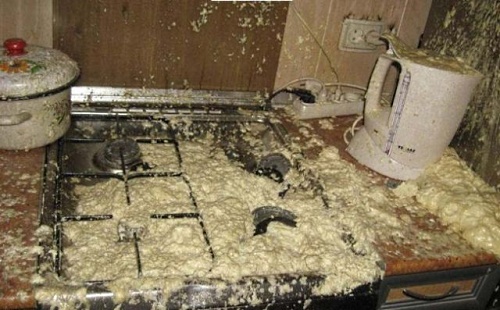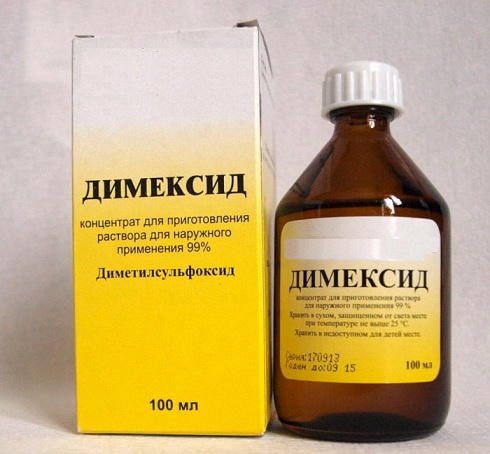Best Methods for Scrubbing Foam from Hands, Clothes, Windows, Doors, and Floor
As a polyurethane sealant, polyurethane foam is tricky. When exposed to open air, it dries quickly, turning into a dense mass, after which you will have to make a lot of effort to remove frozen splashes or smudges. Builders and installers usually use special means for this purpose: Cosmofen, Macroflex, Isofoam R621. If such solvents were not found in the house, try to do with your own strength and improvised substances: salt, acetone, vegetable oil, etc.
Advice. Use gloves when handling polyurethane foam and protect your hair and face from splashes.
 Do not try to heat the can on the stove!
Do not try to heat the can on the stove! How to remove polyurethane foam from your hands
When the contamination is very low, nothing can be done. Polyurethane foam is not toxic and not dangerous, and therefore wait a couple of days - the residues of the substance will come off on their own.
Otherwise, try one of the following methods:
- Rub your hands with coarse table salt (of course, if the skin is intact and there is no irritation). Remove the remaining foam with a cotton pad soaked in purified kerosene or acetone. Use nail polish remover as an alternative to acetone, but keep in mind that it is not as effective.
- Steam your hands in hot, soapy water (both laundry and toilet soaps, shower gel will do). Remove the foam with a pumice stone or a hard washcloth.
- Pamper your hands with a bath of warmed (but not hot!) Vegetable oil. After this procedure, try to scrub the foam with the same pumice stone. More often than not, not a trace will remain of it.
- Once you have dealt with the dirt, treat your hands with a moisturizer or nourishing cream to prevent flaking and irritation of the skin. Store products for removing polyurethane foam from various types of surfaces are absolutely not suitable for hands.
How to scrub foam from windows, doors or floors
The mechanical method is optimal for cleaning the foam that has settled on a smooth surface: glass, metal, durable plastic. Use a rag, stiff brush or sandpaper, or any scraping tool such as a spatula, scraper, or knife.
First of all, remove as much of the foam "cap" as possible. Please note: if the polyurethane did not have time to harden completely and is something like a viscous rubber, then it is removed instantly and without a trace. In the same case, when the curing process is completed, gently prying off the remaining foam, scrape off the foam from the surface. Sand unpainted metal or wood with sandpaper.
At home, to wash the polyurethane foam without a trace will help:
- Saline solution (1 tablespoon of table salt in 1 glass of water). It cleans well wooden, including painted surfaces.
- Acetone and acetone-containing compounds. Effective for surfaces not coated with paint or varnish. Do not use soft plastic and linoleum for cleaning.
- Vegetable oil is used to remove foam on plastic, metal, wood surfaces. Treat the affected area with a sponge soaked in oil, leave for half an hour. Dispose of sealant and grease residues with a cloth dampened with soapy water.
- Craftsmen have found out that the drug "Dimexide" (dimethyl sulfoxide), which is available in every pharmacy without a prescription, copes well with solidified polyurethane. Apply the solution to the contaminated area and leave for 10 minutes, then wipe the surface with a damp cloth. Be careful: work only with protective gloves!
- Simple water will help to clean the linoleum: remove excess foam with a knife or scraper, “cover” the dirt with a well-moistened cloth. After a few hours, all that remains is to wipe the floor.
 Sold in a pharmacy without a prescription
Sold in a pharmacy without a prescription It is not always possible to wash off dried polyurethane foam that has got on clothes. Put the spoiled item in the freezer for several hours: in some cases, the foam that has become fragile and vulnerable can be easily removed from the fabric. If this method does not help, wipe off the dirt with a cotton pad soaked in "Dimexidum". After 40 minutes, brush off any remaining stains and wash clothes as usual.
Trousers and trousers made of dense fabrics (cotton, denim, linen) are treated with white spirit. This solvent is also useful for cleaning leather items.
 In fact, the woman confused polyurethane foam with shampoo ...
In fact, the woman confused polyurethane foam with shampoo ...

